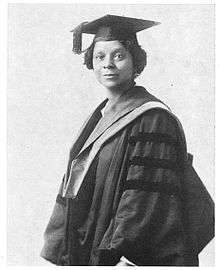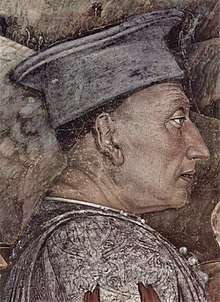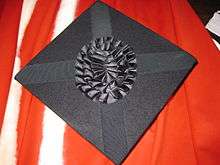Square academic cap
The square academic cap, graduate cap, cap, mortarboard[1] (because of its similarity in appearance to the mortarboard used by brickmasons to hold mortar[2]) or Oxford cap, is an item of academic dress consisting of a horizontal square board fixed upon a skull-cap, with a tassel attached to the centre. In the UK and the US, it is commonly referred to informally in conjunction with an academic gown as a "cap and gown". It is also sometimes termed a square,[3]:17[4] trencher,[3]:17[5]:915 or corner-cap.[4] The adjective academical is also used.[6]


The cap, together with the gown and sometimes a hood, now form the customary uniform of a university graduate in many parts of the world, following a British model.

Origins
The mortarboard is generally believed by scholars to have developed from the biretta, a similar-looking hat worn by Roman Catholic (and High Church Anglican) clergy. The biretta itself may have been a development of the Roman pileus quadratus, a type of skullcap with superposed square and tump (meaning small mound). A reinvention of this type of cap is known as the Bishop Andrewes cap.[7]:22–23 The Italian biretta is a word derived from the Medieval Latin birretum from the Late Latin birrus "large hooded cloak", which is perhaps of Gaulish origin, or from Ancient Greek πυρρός pyrrhos "flame-colored, yellow".[8]
The cone-shaped red (seldom in black) biretta, related to the ancient Etruscan tutulus and the Roman pileus, was used in the fourteenth and fifteenth centuries to identify humanists, students, artists, and learned and blooming youth in general. The shape and the colour conveyed meaning: Red was considered for a long time the royal power, whether because it was difficult to afford vestments of such solid and brilliant dye or because the high symbolic meaning of blood and life, thus the power over life and death.
It is no accident that the capo (captain) headwear is found so often in Renaissance paintings: for example the highly famous one by Piero della Francesca of Federico da Montefeltro with his red cap. Campano wrote about these hats in his Life of Niccolò Fortebraccio, "he used to wear a red and high hat, the higher from the head the wider it became." Federico and Niccolò were Condottieri. The same cap is seen on Bartolomeo Colleoni, commander of the Venetian Armies in 1454, on the Duke Ludovico III Gonzaga and on John Hawkwood in his equestrian monument by Paolo Uccello. This cap as worn by the leading Italian nobles at the end of the fifteenth century became a symbol of their military and civil powers over Italian cities at a time when the whole of Europe was going to be deeply transformed by Italian influences.
It was originally reserved for holders of master's degrees (the highest qualification in medieval academia) but was later adopted by bachelors and undergraduates. In the 16th and 17th centuries corner-cap ("catercap" in the Marprelate tracts) was the term used (OED).
The origins of the most commonly found mortarboard in the United States can be traced to a patent that was filed by an inventor Edward O'Reilly and a Catholic priest Joseph Durham who filed their patent in 1950. Their invention and subsequent patent was the result of his idea to incorporate a fiberglass stiffener into the mortarboard, thus making it more sturdy. Such mortarboards are commonplace throughout the world today.[9]
Variants

Doctorate holders of some universities wear the mortarboard, although the round Tudor bonnet is more common in Britain. The 4, 6, or 8 cornered "tam" is gaining popularity in the US, and in general a soft square tam has some acceptance for women as a substitute for the hard 'square'.
Sometimes the mortarboard is customized with inspirational quotes or decorations referring to the field of study. At some European universities, the mortarboard is made by the postdocs of the research group, and traditionally has some funny references to the person or their project.
In the US, the mortarboard is also worn by high school pupils during the presentation of their diplomas.
Tassel

United Kingdom
In the UK, the tassel is shorter and is gathered at the button at the centre of the board. The U.S. style is slightly longer, gathered at a cord attached to the button.
At the University of Cambridge, undergraduates by ancient convention used to cut their tassels very short so that the tassel does not extend beyond the edge of the board. After they graduated, they wore the square cap with the tassel at the normal length.[10] This convention has now fallen into disuse; few people now wear headgear with academic dress at any time and undergraduates in particular have no need to wear the cap.
United States
In US graduation ceremonies, the side on which the tassel hangs can be important. Sometimes it is consistent among all students throughout the ceremony, in other cases it differs based on level of study with undergraduate students wearing the tassel on the right, and graduate student wearing them on the left. In some ceremonies, the student wears the tassel on one side until reception of the diploma; then it is switched to the other.
At the secondary school level, the tassel is usually either the school's primary colour or a mix of the school's colours with as many as three colors in a tassel. Sometimes a tassel of a distinctive colour, such as gold, is worn by those graduating with Latin Honours (i.e. cum laude) or on the "honour roll".
Universities in the United States might use tassels in black or the school's colors, usually for higher degrees.
For bachelor's degrees the tassel may be colored differently from the traditional black or school colors to represent the field (or one as closely related as possible) in which the wearer obtained his or her education. In 1896 most colleges and universities in the United States adopted a uniform code governing academic dress. The tassel may be adorned with a charm in the shape of the digits of the year.
The American Council on Education (ACE) code states that "The tassel should be black or the colour appropriate to the subject," and only makes an exception for the gold tassel. The gold metallic tassel is reserved for those entitled to wear the doctoral gown, as is the use of velvet for headwear. Only one tassel is worn at a time.
| Faculty | Colour | Sample |
|---|---|---|
| Agriculture | Maize | |
| Arts (Liberal Arts), Letters (Literature), Humanities | White | |
| Commerce, Accountancy, Business | Drab | |
| Dentistry | Lilac | |
| Economics | Copper | |
| Education | Light Blue | |
| Engineering | Orange | |
| Fine Arts, Architecture | Brown | |
| Forestry, Environmental Studies, Sustainability | Russet | |
| Journalism | Crimson | |
| Law | Purple | |
| Library Science, Information Management | Lemon | |
| Medicine | Green | |
| Music | Pink | |
| Nursing | Apricot | |
| Oratory, Speech, Broadcasting | Silver Gray | |
| Pharmacy | Olive Green | |
| Philosophy | Dark Blue | |
| Physical Education, Manual Therapy, Physical Therapy | Sage Green | |
| Public Administration, Public Policy, Foreign Service | Peacock Blue | |
| Public Health | Salmon Pink | |
| Science (both Social and Natural) | Golden Yellow | |
| Social Work | Citron | |
| Theology, Divinity | Scarlet | |
| Veterinary Science | Grey |
For schools where the graduation regalia is rented or borrowed by the student, the tassel might be a part of the rental or provided separately. Some schools that do not provide a tassel for graduates to keep may offer a souvenir tassel that is not worn with the regalia.
Traditional wear

As with other forms of headdress, academic caps are not generally worn indoors by men (other than by the Chancellor or other high officials), but are usually carried. At the University of Oxford, caps are mandatory dress for matriculation events and for all examinations. It is a commonly repeated myth at Oxford that the cap must be held and may not be worn at all except at the student's graduation; however, there is no rule in the University to this effect, and undergraduates wearing formal academic dress may either carry the cap or wear it. In particular, women undergraduates who exercise the right to wear a soft "Canterbury" cap must wear it on their head, rather than carrying it.
In some graduation ceremonies caps have been dispensed with for men, being issued only to women, who do wear them indoors, or have been abandoned altogether. This has led to urban legends in a number of universities in the United Kingdom and Ireland which have as a common theme that idea that the wearing of the cap was abandoned in protest at the admission of women to the university. This story is told at the Universities of Cambridge, Dublin, Durham, Bristol, St Andrews, and the Queen's University, Belfast among others. In Ireland, a common belief [11], holds that only women wear the mortarboard because a bachelor's degree was thought to be the maximum education they could attain and thus represented the 'capping' of their education, however there is little evidence for this. Dr. David Fleming of the History Department at the University of Limerick called this reason 'complete nonsense and an urban myth', while the University's gown partner, Phelan Nolan said 'Women used to wear hats in Church and that is where the tradition has come from'.[12]
There are several types of mortarboard that are usually made. The most common in the UK is the 'folding skull' in which the skull part can be folded for ease of storing and carrying. Traditionally, the mortarboard had a 'rigid skull' which is considered more aesthetically pleasing and better fitting than a folding-skull one. In addition, the rigid skull type has the advantage of being easier to doff than the folding skull version, as there is no possibility of the skull collapsing in on itself. Many degree ceremonies in British universities include the ritual doffing of caps. Both types require the wearer to wear the appropriate size to fit. In the US, an 'elasticated skull' is mostly used which eliminates the need to make many mortarboards in different hat sizes. Some mortarboards, especially those in east Asia are laced-up at the back of the skull cap.
The correct way to wear a mortarboard is to have the larger part of the skull of the mortarboard at the back of the head with the top board parallel to the ground. A proper fitting mortarboard should not fall off easily.
Until the second half of the twentieth century, mortarboards were often worn by schoolteachers, and the hat remains an icon of the teaching profession.
Mortarboards are often seen in party supply shops in the United States in May and June, when they appear in the form of party decorations, on commemorative gifts such as teddy bears, and on congratulatory greeting cards.
Mourning cap
There is a version of the mortarboard that is worn during mourning. Instead of a tassel and button on top of the board there are two black ribbons that are attached from corner to corner of the board forming a cross. At the centre where the two ribbons intersect a black ribbon rosette is attached. The ribbon for the wide ribbons is grosgrain ribbon whilst the rosette can be made of either the same grosgrain or satin. This mourning cap can be worn when mourning a personal friend or a family relative.
Another version has nine ribbon bows called "butterflies" attached to the back of the skull cap (three running vertically down the back seam, two vertically eitherside further towards the sides and one eitherside at the sides of the skull) in addition to the above. This cap is worn during the mourning of the monarch, a member of the royal family or the university chancellor.[13]
The mourning cap is worn with mourning bands (normal bands but with a pleat running down each band) and a mourning gown which is either a Cambridge DD undress gown with "pudding-sleeves" but in black stuff rather than silk as worn in the sixteenth-seventeenth centuries or a plain black stuff gown. Hoods are not worn, as they are considered festal items. However, Cambridge proctors in the past wore their MA hoods squared, so as to conceal the lining; since the lining was white it did not clash with the black and white color scheme of mourning.
See also
Notes
- mortarboard. Archived 2008-08-28 at the Wayback Machine The American Heritage Dictionary of the English Language: Fourth Edition. 2000.
- Mortarboard. Entry at Dictionary.com.
- Groves, Nicholas (2011). Shaw's academical dress of Great Britain and Ireland (3rd ed.). Burgon Society. ISBN 9780956127235.
- Robinson, N F (1905). "The Pileus Quadratus: An enquiry into the relation of the priest's square cap to the common academical catercap and to the judicial corner-cap". Transactions of the St Paul's Ecclesiological Society. 5: 1–16. Retrieved 14 May 2015.
- Brewer, E Cobham (1896). Brewer's Dictionary of Phrase and Fable. Retrieved 14 May 2015.
- Chapter II, University of Cambridge Ordinances.
- Goff, Philip (1999). University of London Academic Dress. London: University of London Press. ISBN 0718716086.
- "biretta". Online Etymology Dictionary.
- US patent #2880423
- Hoyle, Sir Fred, Home is where the wind blows, University Science books, 1994
- "Janine Dalton Blog".
- ""Are mortarboards really optional for graduating women?"". February 9, 2017.
- Hargreaves-Mawdsley, A History of Academical Dress in Europe Until the End of the Eighteenth Century (1963), p.137
References
- Goff, Philip (1999). University of London Academic Dress. London: University of London Press.
External links

